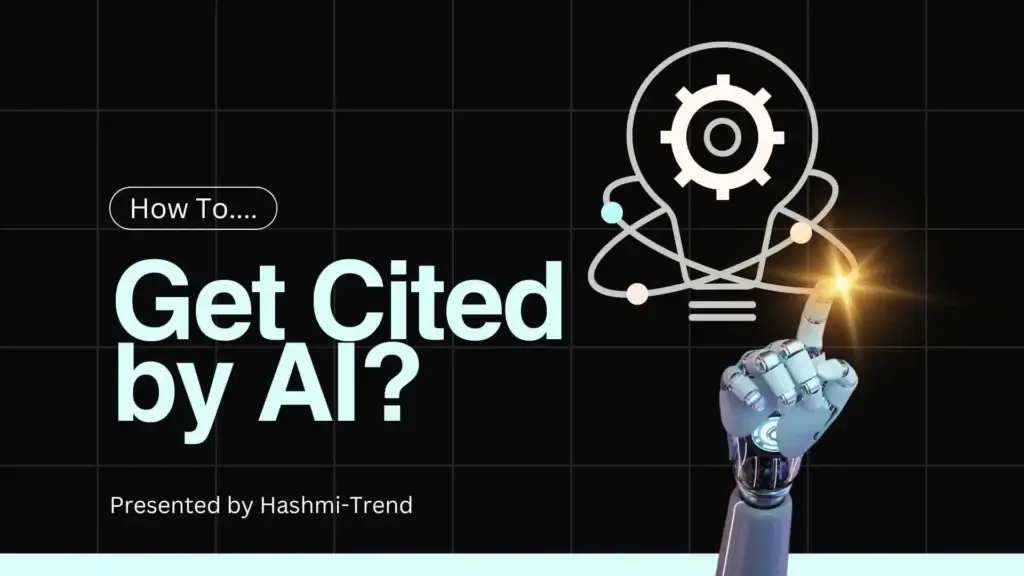TL;DR: If you want to get cited by AI, focus on clear, testable content shapes (short direct answers, FAQ blocks, tables), strong provenance signals (author info, citations, backlinks), and placement where LLMs crawl (public, indexable pages, platforms). Run A/B tests that measure citation pickup (not just clicks). Downloadable lead magnet idea: AI Citation Playbook (Google Sheet + 5 page templates + experiment tracker).
Intro — what you’ll learn
This post shows how to get cited by AI with a tight, tactical 9-step playbook, experiment templates you can copy, signals that matter (schema, freshness, provenance), and a checklist of quick wins to start testing today. If you want visibility inside ChatGPT, Gemini/SGE, or Perplexity-style answers, treat citations as a product metric, not just an SEO vanity stat.
Why AI citations matter (quick ROI logic)
AI citations are the new kind of brand real estate: being the source behind an AI answer gives you authority even when users don’t click. That shows up as:
-
Direct brand mentions inside AI outputs (increases trust).
-
Traffic & leads via “read more” or “source” clicks when present.
-
Top-of-funnel pipeline: corporate buyers, journalists, and creators use AI answers as discovery.
Search Engine Land’s analysis of ~8,000 AI citations shows there are repeatable patterns in what gets quoted — so this is testable, not just guesswork.
What AI engines actually cite — patterns that help you get cited by AI

Different AI systems use different signals. Broad patterns across major engines (ChatGPT/Perplexity/Gemini/SGE):
Common winner formats
-
Short, factual snippets and lists (FAQs, bullets).
-
Clearly dated, well-sourced pages (provenance).
-
Authority signals (author bios, citations, publications).
-
Structured content (tables, schema, FAQs).
Citation sources analysis
-
Search Engine Land study: many citations came from high-authority, topical pages and a mix of forums, news, and institutional sites. That means both formal sources and well-structured community content can win.
-
Perplexity and similar tools emphasize source transparency — they prefer pages they can index and link to directly. Make sure your pages are crawlable and present clear, sourceable facts.
9-step Tactical Playbook (short, action-first)
Follow these steps in order; each is immediately testable.
-
Direct answer lead — Put a one-sentence direct answer at the top (answer seeker format). Example: “Yes — you can get cited by AI by publishing short, sourceable FAQs and data tables.” Put the primary keyword within the first 50–100 words.
-
Structured snippets — Use H2/H3 + bullets + one short table per page (facts, figures, dates). LLMs reuse tables.
-
Anchor facts — Add 3–5 verifiable facts (dates, numbers, citations). Where possible, include a one-line source link next to the fact.
-
Author & provenance — Add a clear author bio, affiliation, and contact. This raises trust signals.
-
Schema & FAQ markup — Implement
FAQPageandArticleJSON-LD; addpublisheranddatePublished. (Example JSON-LD below.) -
Place where models crawl — Publish on indexed pages, and cross-post to trusted third-party platforms (industry hubs, Medium, GitHub Gists, preprint servers) to seed LLMs. This is LLM seeding.
-
Strong internal linking — Link the page from topical hub pages and resources lists — that creates context and entity signals.
-
Backlinks from trusted sources — Prioritize 1–2 authoritative links (gov, edu, large publishers) or citations from respected aggregators.
-
Measure citation pickup — Track when AI platforms cite you (see tools below) and iterate.
Experiment templates — A/B tests you can run today
Run these as simple experiments (goal: citation pickup).
| Test | Variant A | Variant B | Metric |
|---|---|---|---|
| Format | Long narrative guide (2,000 words) | Short 800-word page with 3 FAQs + table | # of AI citations (per tool), clicks from source |
| Schema | No schema | FAQPage + Article JSON-LD |
Citation pickup % |
| Provenance | Authorless page | Page with author & affiliation + citations | % of times cited with link |
Experiment steps
-
Create two-page variants.
-
Index both (submit sitemap/request indexing).
-
Wait 7–14 days (some engines are faster).
-
Use Perplexity/Prompt queries and track citations manually, or utilize AI-tracking features in SEO tools (e.g., Conductor). Record citation frequency and click-through rate.
Signals that increase citation probability (practical list)
-
Schema markup:
Article,FAQPage,HowTowhere relevant. -
Freshness: Add
datePublishedanddateModified. Many citations skew to recent content. -
Provenance links: Link to primary sources inline. LLMs prefer sourceable facts.
-
Clear formatting: short paragraphs, bullets, tables.
-
Accessible crawl path: do not block AI crawlers in robots.txt if you want to be discoverable. (But weigh legal/licensing choices — see warning below.)
Example JSON-LD (FAQ snippet) — drop in <head>:
How to convert citations into traffic & leads
-
Use short contextual CTAs under your facts: “Want the full dataset? Download CSV.” (Keep CTAs non-pushy.)
-
Capture the next step: offer the downloadable “AI Citation Playbook” in exchange for an email address.
-
Make the source clickable: when an AI shows a citation, users often click “source” — make that destination short, useful, and optimized for conversions (lead form + resource).
Tracking tips
-
Use tools that report AI visibility (Conductor, some enterprise tools) and manual sampling via Perplexity/Gemini to detect citations. Record citation velocity (citations/week).
Warnings & legal / reliability notes
-
Access & rights: Some publishers have blocked AI crawlers or sent take-down notices; that can change who gets cited. Perplexity and other firms have had disputes with publishers. If you rely on third-party platforms, watch robots.txt and publisher agreements.
-
Hallucinations & fake citations: AI can misattribute facts — make your facts verifiable and include URLs/DOIs for critical claims. Legal systems are already flagging fake AI citations, so accuracy matters.
FAQ (8 high-intent Qs)
-
Q: How fast do AI citations appear?
A: Varies by engine — some show results within days; others take weeks. Track weekly for 4 weeks. -
Q: Do I need a schema to be cited?
A: No, but schema helps AI understand structure—use it for a measurable lift. -
Q: Are backlinks still important?
A: Yes — authority links help. But format + provenance often win over raw link volume. -
Q: Should I publish the same content everywhere?
A: Publish a canonical long version on your site and short, unique summaries on other platforms to seed LLMs. -
Q: How do I measure “citation pickup”?
A: Use enterprise tools (Conductor), manual sampling (Perplexity/Gemini queries), and your experiment tracker. -
Q: Are community sites (Reddit, StackExchange) useful?
A: Yes — they’re often cited. But ensure your post is high-signal and clearly sourced. -
Q: Will AI citations replace organic traffic?
A: Not fully. They shift user behavior — some users click, others don’t. Optimize for both citations and conversion. -
Q: Do paid or gated pages get cited?
A: Generally no—public, crawlable pages are preferred. Consider short public summaries and gated full downloads.
Conclusion
If your goal is how to get cited by AI, treat it like a measurable product: publish short, sourceable answers, add schema + author/provenance, seed content where LLMs crawl, and run A/B tests that track citation pickup (not just rankings). Start with the eight quick wins, build the experiment tracker, and publish your first reproducible result — that’s the content gap most competitors haven’t filled.



